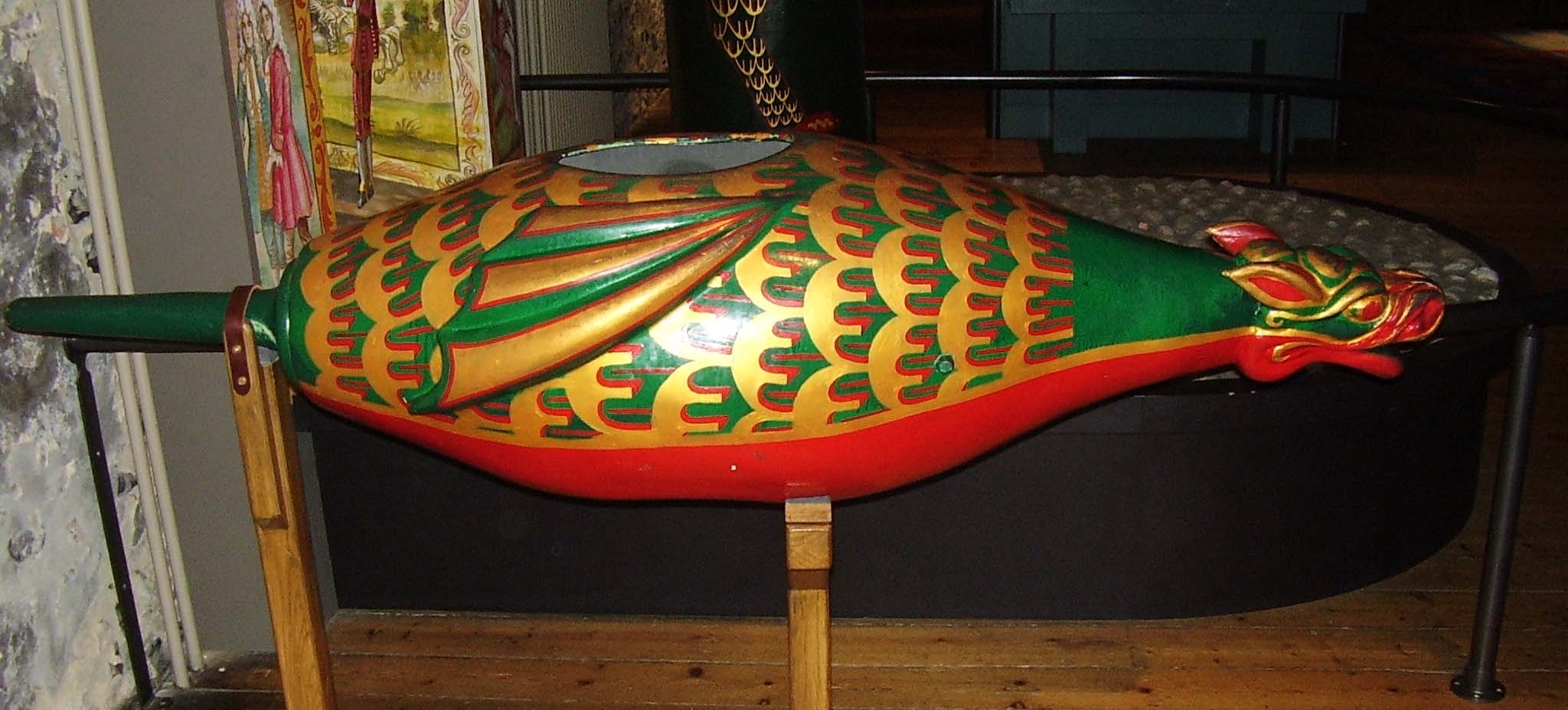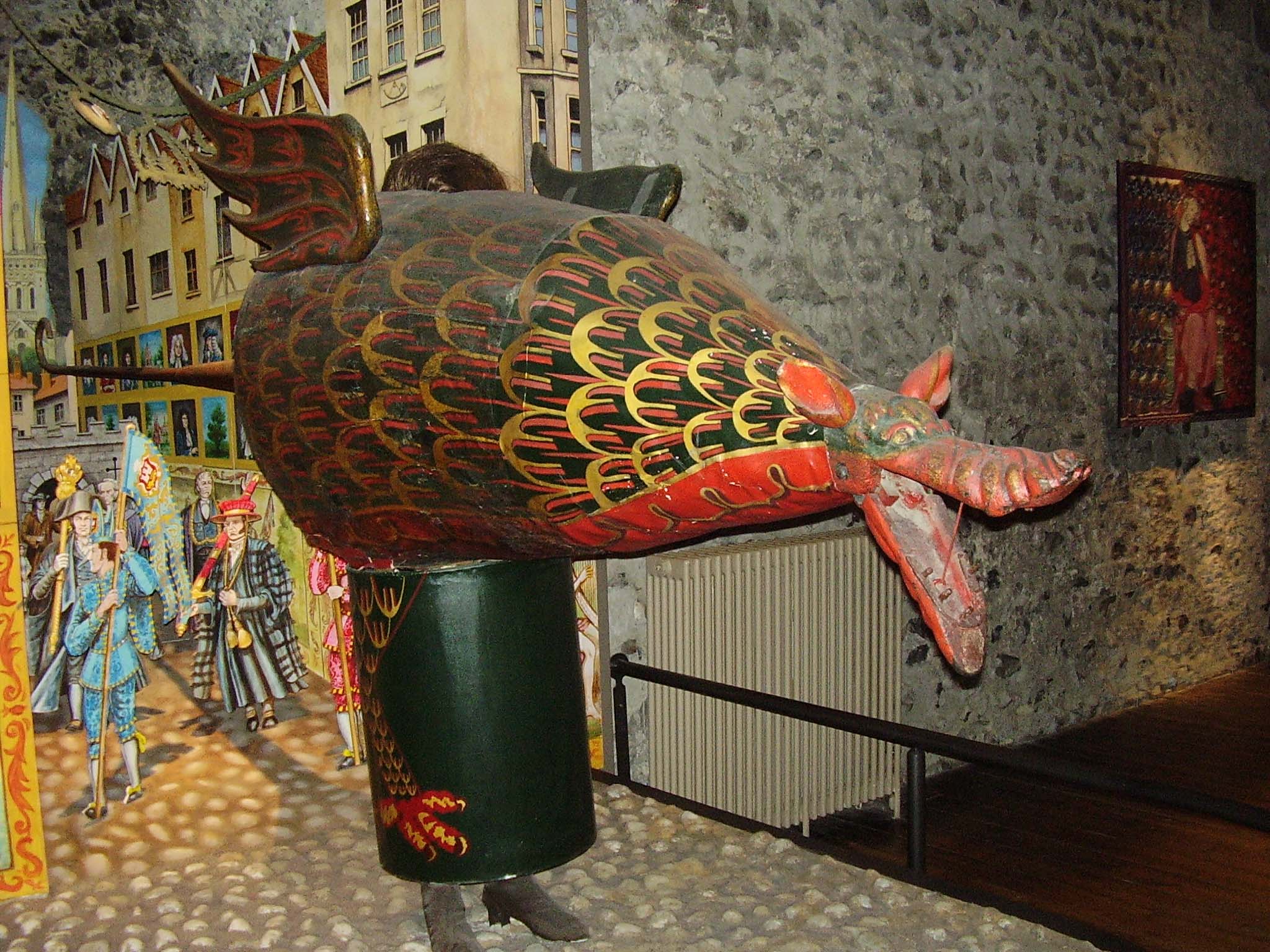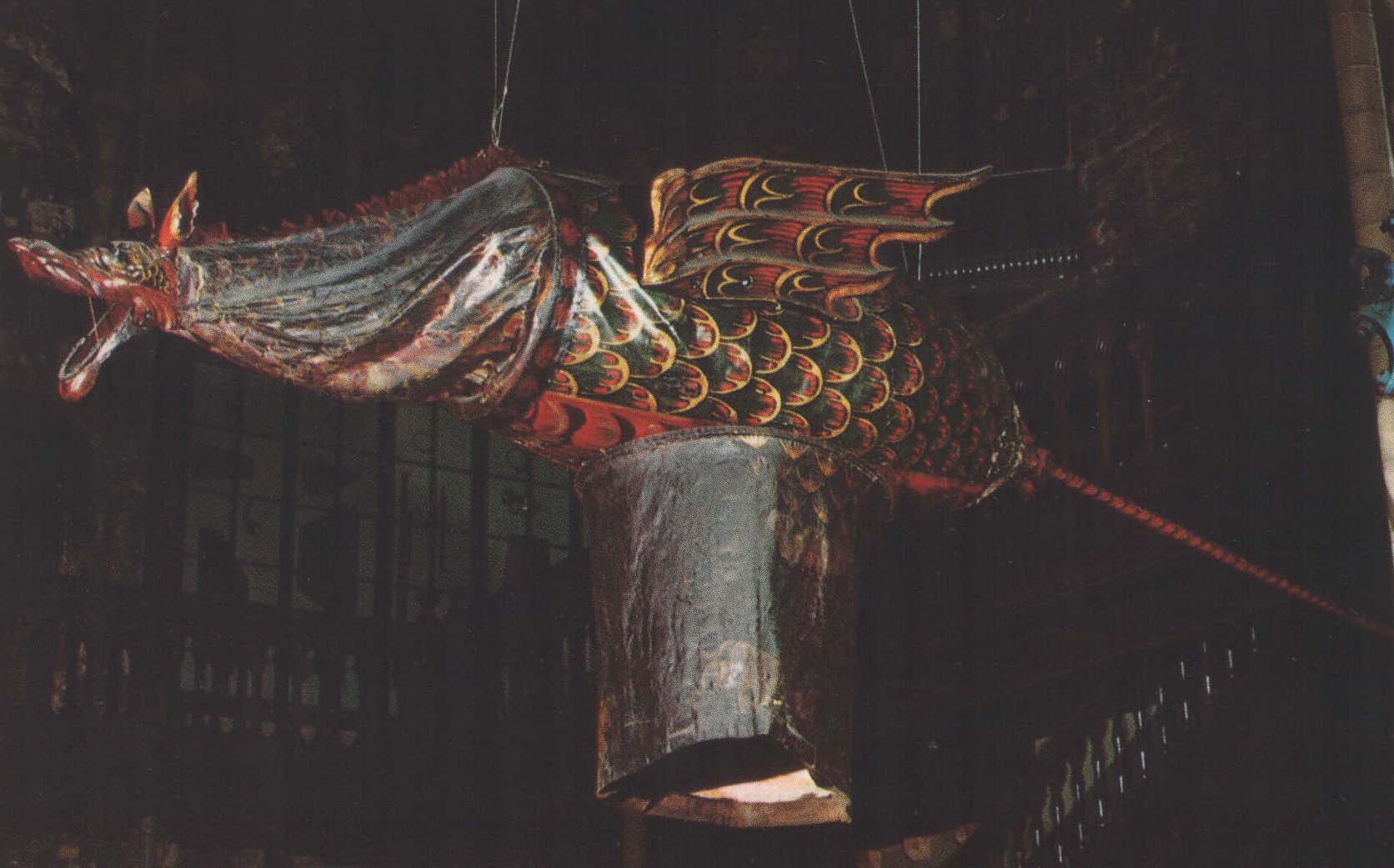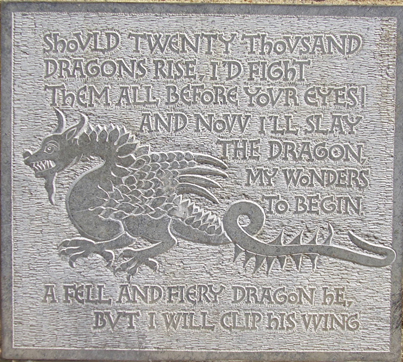Snap the Norwich Snapdragon
'Snap, Snap, steal a boy's cap, give him a penny and he'll give
it back'
The Norwich dragon, known affectionately as 'Snap', is preserved
in a remarkable collection at Norwich Castle Museum. A long-
established civic ceremonial which persisted, in a modified form,
until earlv this century included the snapdragon as the herald of
the grand annual Guild Dav procession held at the inauguration of
the new Mayor. The cavorting dragon was an obvious source of
amusement and entertainment for the crowds watching the proces-
sion but in earlier times it had a religious significance as part of
a
pageant performed by the Guild and Fraternity of St. George of
Norwich. Three snapdragons survive more or less complete, one
of which is the last of the civic Snaps, the others being later copies.
The Guild of St. George 1385-1548
The history of the snapdragon is inextricably linked to that of the
Guild. Founded in 1385 its aims were religious, charitable and
social: to honour St. George and keep his feast day, to pray for its
members past and present and to offer alms to the poor and needy
within the Guild.
The Guild had a small chapel at the Cathedral dedicated to St.
George and a priest was paid an annual salary to say Mass there
daily for the welfare of the members. The principal event for the
Guild was the feast day ceremony held annually on 23 April. This
consisted of a procession to the Cathedral for Mass, followed by a
grand banquet.

Photo of small 'Snap' - Norwich Museum 2006
influence on the City as did other guilds, but its fortunes changed
significantly in 1417 when it was granted the prestigious honour of
a Royal Charter by Henry V. This may have resulted from the
King's acquaintance with prominent Guild members who fought
with him at Agincourt. The Charter elevated the status of the
Guild and broadened its outlook. It was no longer just a religious
fraternity but an organisation with secular rights and privileges
protected by a Royal Charter, and it soon developed into a very in-
fluential body within the City.
The first half of the fifteenth century was an unsettled time in
Norwich as a series of power struggles broke out in which promi-
nent guilds were involved. Members of St. George's Guild were
accused of trying to influence the mayoral election of 1430 and
were involved in other plots against the ruling body of the City.
These damaging rifts were finally settled in 1452 m an agreement
known as 'Yelverton's Mediation' in which the structure of the
Guild was firmly linked with that of the City administration.
Under this agreement the two bodies were to be brought closely
together. This was achieved by the election of the outgoing Mayor
to the position of head or 'Alderman' of the Guild. The Aldermen
of the City automatically became members of the Guild and the
lesser civic officers known as 'Common Councillors' were also
given the right to become members. This agreement settled the
disputes and as a result membership of the Guild came more or
less to overlap with that of the Corporation.
Membership of-the Guild was. in-theory open to everyone but
the high membership fee inevitably discouraged poorer people
from joining. The Guild often numbered more than 200 members
among whom were some of the most powerful, wealthy and in-
fluential people in Norwich and Norfolk. Most members were
laymen but there were also some clerics and some women. The
Guild did not have its own guildhall,unlike some of the important
livery companies and craft guilds of London or York. However, in
1486 the Corporation gave it the top chamber of the Guildhall so
that it could keep its property and hold its meetings here.
The year 1547 marked a turning point in the history of the
Guild. The Protestant government of Edward VI sought to abolish
all guilds, brotherhoods and fraternities by Act of Parliament as
they were thought to foster religious superstition. The Guild's
Royal Charier and its intimate ties with the City Corporation
enabled it to survive the Act, although it lost its religious functions.

Photo of larger 'Snap' - Norwich Museum 2006
The Company of St. George 1548-1731
In 1548 the Guild's title was changed to 'the Company and Citizens
of St. George', and new ordinances were drawn up which omitted
any mention of religious dedication and devotion to St. George.
A brief revival of old Guild customs was possible in the reign of
the catholic Queen Mary and in 1554 the Company repealed all the
new ordinances they had drawn up since the death of Henry VIII.
Its former name was restored and an attempt was made to buy back
property and goods which had been sold off. This revival only lasted
until the accession of Elizabeth I and the return of Protestantism.
The close identification of the Company and Corporation was
consolidated in 1584 when a meeting of the City Assembly decided
to combine the two separate celebrations of the St. George's Feast
Day and the installation of the new Mayor. The day chosen was the
Tuesday before Midsummer's Eve (23 June). From 1585 to 1731
the Company organised the Mayor-making ceremony on Guild Day
and developed it into a sumptuous spectacle for which Norwich
became justly famous.
Throughout this time the Company continued to enforce its rules
as if they were public laws in spite of the fact that its former powers
had been abolished by the Act of Edward VI. The ruling council of
the Company was called the Assembly of the Feast of the Mayor,
Sheriffs, Citizens and Common Council. When new members were
chosen they were summoned to appear before the Assembly to take
the oath of the brethren. Although membership was at first com-
pletely voluntary a strong element of coercion was gradually in-
troduced. If a person was elected to the Corporation he was
automatically expected to join the Company. If he refused, the
threat of a fine, seizure of goods and, as a last resort, imprisonment
invariably secured his consent.

Postcard scan - Norwich Museums
The Assembly also chose four feast-makers each year who were
responsible for the planning of the banquet in the New Hall (St.
Andrew's Hall) on Guild Day. Although it was an honour to be
chosen a feast-maker, it also entailed a heavy financial burden as
they were expected to pay for most of the costs of the lavish ban-
quet. Those who refused to serve in this office faced a fine, or im-
prisonment until the fine was paid. A member could buy exemp-
tion from being elected a feast-maker for a number of years.
In this way the Company was able to amass considerable
sums of money, much of which went into the embellishment of the
Guild Day festivities, and much of it also paid for the entertain-
ment of members in City taverns or inns after meetings.
Although there was opposition from members who incurred
financial penalties from time to time, the commanding position of
the Company was never seriously challenged until 1729 when
Alderman William Clarke began a sustained attack on the legality
of the Company's actions, the outcome of which was the collapse
of the Company and the surrender of all their goods and posses-
sions to the Corporation in 1731. Increasingly such activities were
seen as part of a corrupt system of local government and were
organised directly by the Corporation, until swept away by the
reforming Municipal Corporations Act of 1835.
Guild Day.
The Guild Day procession began as a simple religious celebration
of the feast day of St. George on 23 April which grew steadily in
size and importance as the Guild's relationship with the City Cor-
poration deepened. By the end of the sixteenth century it was no
longer a civic religious ceremony but a civic secular ceremony
which celebrated the coming to office of the new Mayor. For this
no expense was spared.
Although the form of the procession changed over the centuries,
the dragon remained as pan of the pagentry for over 400 years.
The earliest reference to the dragon comes from the minutes of the
Guild Assembly of 1408 at which it was agreed 'to furnish priests
with copes, and the George shall go in procession and make a con-
flict with the Dragon, and keep his estate both days'. St. George
riding on horse-back and fighting the dragon was the centre-piece
of the Guild Procession. In 1532 or shortly before, a third figure
joined them; this represented the maiden rescued by St. George,
and is recorded as 'The Lady', 'The Maid' or 'The Margaret'. A
swordbearer, carrying the Guild sword reputedly given by Henry
V at the time of the Charter, led the procession with priests, the
City Waits, Cantors from the Cathedral and the City and Guild of-
ficials following.
After the Reformation the Company found it expedient to make
certain modifications to the form of the ceremony. In 1553 they
agreed that on the following feast day '. . . there shall be neither
George nor Margaret; but for pastime, the Dragon to come and
shew himself as in other years.'
In 1585 the two separate celebrations, that of Guild Day in April
and that of the swearing in of the new Mayor of Norwich in June,
were combined to create one grand event on the Tuesday before
Midsummer's Eve. Over the next 150 years the pattern of the
Guild Day celebrations remained the same. However, the scale
and splendour of the occasion increased, gradually reaching its
height at the beginning of the eighteenth century.
During this time the ceremonies began the afternoon before
Guild Day when the Company attended a service in the Cathedral.
Afterwards they marched in procession to the New Hall (St.
Andrew's Hall) where the meeting was held to elect the twelve
members (later six) known as the Honourable Company of St.
George, who would preside over the arrangements for the proces-
sion and feast the following year. In the evening the guns in the
Castle ditches were fired and the bells of the City churches rung "o
mark the start of Guild Week.
A local historian, Benjamin Mackerell, has left us a description
of the Guild Day festivities in the early years of the 18th cenlur'.',
On Guild Day the old Mayor, Sheriffs, Aldermen, the Si.
George's Company and Common Councillors met at eight o'ciocx
in the morning at the house of the newly elected Mayor (or
Newlex) where they enjoyed sugar rolls and wine. The '.vhoie
street (formerly the whole parish) where the new Mayor lived -A'as
decorated . The street was strewn with green -^shes
and planted with trees. The outsides of the houses were hung with
tapestries and pictures, particularly the new Mayor's house. From
here the dignitaries then paraded on horseback to the house of the
retiring Mayor where a substantial breakfast of pasties, roast beef,
boiled legs of mutton and wine were provided. The procession
then set out for the cathedral. The way was cleared by six Whif-
flers and two Dick Fools accompanied by the dragon. Mackerell
says 'The Dragon, carried by a Man in the body of it, gave great
diversion to the common People: they always seemed very much to
fear it when it was near them, but always looked upon it with
pleasure when it was a little distance from them'. The Whifflers
were dressed in a distinctive costume of scarlet satin breeches,
white satin jerkin and a hat decorated with a cockade of feathers
and ribbons. They carried swords which they brandished and toss-
ed in the air. Helping the Whifflers were the Dick Fools, who
wore painted canvas coats with red and yellow cloth caps adorned
with fox or cats' tails and small bells.
After a sermon in the Cathedral the procession re-formed for the
journey to the Guildhall. Behind the Mayor, who rode with the
Sheriffs in violet and Aldermen in scarlet gowns, came a standard
bearer carrying the Standard of England and then the City Music
'playing them along the streets'. The St. George's Company
followed, led by a standard bearer carrying the Company's Stan-
dard. The Common Councillors brought up the rear.
As the new Mayor approached the entrance to the Royal Gram-
mar School within the Close he was addressed in Latin by a senior
pupil known as an orator, who delivered a short speech 'commen-
ding justice and obedyence'. A number of other boys were station-
ed on horseback along the route back from the Cathedral and they
made further short speeches in English to the new Mayor. These
'speech boys' were richly dressed and carried small paste-board
shields decorated with scenes, some of which refer to the Mavor's
procession.
At the Guildhall the Mayor took the oath and was invested with
his insignia of office. After the customary speeches all of the
dignitaries departed in the same order for the New Hall :o take
part in the lavish Guild feast attended at times by up to 800 peo-
ple. As soon as the feast was over, the Company chose the feast-
makers for the ensuing year, their choice being signified by :he
presentation of a garland of flowers.
From the New Hall the Court, Company and Common Coun-
cillors retired to the new Mayor's house where sugar rolls and
wine awaited them and the day concluded with yet more food and
wine at the old Mayor's residence. The crowds of people who
came to see the ceremonies were entertained by shows during the
dav and a grand firework display in Tombland in the evening.
With the demise of the St. George's Company in 1731, Guild
Day continued, but on a much more modest scale. The Mayor was
provided with an allowance sufficient to cater for some 500 to 600
guests, the Guild Breakfast was ended and later a ball was provid-
ed at the Assembly Rooms in the evening. Although the Company
was disbanded the dragon. Fool and Whifflers were kept on and
they continued to appear in the annual procession, their wages
now being paid by the Corporation. Several alterations were made
to the procession with regard to the order of officials and the in-
troduction of units of the militia. In 1772 carriages were used in-
stead of horses to permit the wives of members of the Corporation
to join the procession. With the passing of the Municipal Corpora-
tion Reform Act of 1835 much of the pagentry of corporate
boroughs disappeared and that year saw the last Guild Day
Ceremony. The popularity of the civic snapdragon was such that it
continued to appear occasionally until 1850.
Mock-Mayoral Processions
Towards the end of the eighteenth century mock-Mayoral proces-
sions were introduced. Mock Guilds were established in
Pockthorpe, a poor district of Norwich, and Costessey, a village on
the outskirts of the City. These Guilds elected a 'Mayor' who was
sworn into office with a good deal of pomp and ceremony in imita-
tion of the Norwich Guild Day. They had their own processions
complete with snapdragon and mock officials.
The Pockthorpe Guild, founded in 1772, held its activities on
the day following Guild Day. In the morning the Mayor and his
officials were installed on the village green. They were then led in
procession by the Guild's snapdragon around the district with
stops at various inns on the way for refreshment. In the afternoon
the inhabitants were entertained by a fair in the grounds of a local
tavern and a series of amusing sports and contests.
With the ending of the Guild Day procession, the tradition of
parading the snapdragon was carried on in Norwich by the
Pockthorpe Guild. By the 1880s much of the mock pomp had gone
and the appearance of the Pockthorpe Snap had degenerated into a
boisterous money-raising activity which involved the dragon being
carried around the streets of Norwich attended by men with collec-
ting boxes. The dragon caused much hilarity by chasing people
with the intention of grabbing their hats or caps between its jaws
and returning them only after a penny ransom had been paid.
Young boys would taunt the dragon by running close by and chan-
ting 'Snap, Snap, steal a boy's cap, give him a penny and he'll give
it back'. The annual revelries continued until early this century.

Found in Norwich Castle Grounds